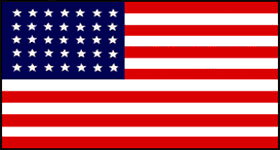 |
Civil War Battles |
|
State War Records |
| AL - AK - AZ - AR - CA - CO - CT - DE - FL - GA - HI - ID - IL - IN - IA - KS - KY - LA - MA - MD - ME - MI - MN - MS - MO - MT - NE - NV - NH - NJ - NM - NY - NC - ND - OH - OK - OR - PA - RI - SC - SD - TN - TX - UT - VT - VA - WA - WV - WI - WY |
The Battle of Waynesborough
March 2, 1865 in Waynesborough, Augusta County, Virginia
 |
|||||||||||||||||||||
|
On February 27th, 10,000 cavalrymen under Maj. Gen. Philip H. Sheridan left Winchester, Virginia and advanced southward through the Shenandoah Valley toward Staunton and Lynchburg. Gen.-in-Chief Ulysses S. Grant had ordered Sheridan to wreck Confederate railroads and canals near the latter town before turning east to join other Union commands.
Near Staunton stood the only barrier to Sheridan's progress: Lt. Gen. Jubal A. Early's 1,800-man army, the pitiful remnant of a once proud force that Sheridan had virtually annihilated the previous September and October at Winchester (Third), Fisher's Hill, and Cedar Creek.
During the first days of the march, the Federals confinscated Confederate supplies, secured some bridges above Staunton, burned others, and bested Early's cavalry. On March 1st, the Federals occupied Staunton, forcing Early to relocate to Waynesborough, about as dozen miles to the east. There, at the foot of Rockfish Gap, a strategic defile through the Blue Ridge Mountains, Early attempted to make a stand with 2 infantry brigades and an artillery battalion.
In Staunton, over 90 miles southward, Lt. Gen. Jubal A. Early, commanding a remnant of his once-fearful Valley army, endeavored to thwart Sheridan's movement. Throughout the 28th, fewer than 200 Confederate cavalry vainly sniped at the overpowering Union command. Only streams, swollen by winter freshets and icy rainstorms, hampered the Union advance, which arrived at Staunton on March 1st. The Federals found deserted streets and empty warehouses, their contents emptied by Early's troops.
Sheridan entered the town the next morning and ordered Maj. Gen. George A. Custer's cavalry in pursuit. Custer's troopers encountered Brig. Gen. Gabriel C. Wharton's 1,700 Confederates on a range of low hills in front of Waynesborough. With his back to a swollen river, Wharton stretched his line of troops to critical limits.
The enterprising Union cavalry officer carefully reconnoitered the Confederate position, discovering a gap of 1/8 mile between Wharton's left flank and the river. Shortly after 3:30 P.M., 3 dismounted Union regiments knifed into the gap. The stunned Confederates managed to fire a few shots before running.
A Union brigade then galloped into Wharton's center., and the Confederate line dissolved. Early tried to rally his men before fleeing himself. In the rout, more than 1,500 Confederates were captured, along with nearly 200 wagon, 14 cannon, and 17 flags. Early and a few of his staff evaded capture.
Sheridan crossed the Blue Ridge to Charlottesville and then raided south, destroying the James River Canal locks near Goochland Court House. With the valley Confederates dispersed, Sheridan spent 4 weeks destroying barns, mills, the Virginia Central Railroad, and the James River Canal. Electing not to attack heavily guarded Lynchburg, he turned in triumph toward the Petersburg front, where on the 28th, he joined Grant and the Army of the Potomac just in time to participate in the Appomattox Campaign.
The engagement at Waynesborough closed the Shenandoah Valley chapter of the Civil War.
